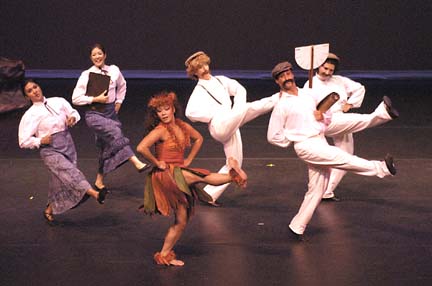
COURTESY KURT DOIRON
A turn-of-the-20th-century scientific expedition arrives to probe the volcano's mysteries, and Pele puts them through their paces in Honolulu Dance Theatre's performance of "The Legend of Pele," performed last weekend.
‘Pele’ was
well-chosen
season finale
"That one I understood," a woman said as the house lights came up and the audience began to trickle out of the Hawaii Theatre following Honolulu Dance Theatre's matinee performance of "The Legend of Pele" on Saturday.
"Pele," repeated that evening and on Sunday, was HDT director/choreographer Matthew Wright's latest successful experiment in combining different styles of traditional and modern dance. "Pele" included hula-style movements as well as ballet and modern Western dance, and, with Celia Chun in the title role, presented an easy-to-understand version of a familiar Hawaiian story in a fast-paced colorful form.
Pele finds her search for a home thwarted by her powerful sister, the ocean goddess Namakaokaha'i (Kara Yoneshige), because, as the narration explains it, "fire and water can't mix." Pele eventually reaches the Hawaiian islands with an assist from her brother, the shark god Kamohoali'i (Ian Campbell), but Namakaokaha'i follows Pele to Kaua'i and kills her.
The fire spirits resurrect Pele, who ends up on the Big Island, a place she can finally make her home. All is well until a group of scientists finds her. Pele tolerates their inquisitiveness at first -- she even shows off her flexibility by raising her left foot, ballet-style -- but her aloha for the visitors vanishes when one of them snatches her head lei. The ground shakes, the scientists quake in terror, and lava flows chase them from Pele's domain.
WRIGHT'S stagings of "Billy the Kid," "Frankenstein" and "King Kalakaua's Nutcracker" have all been worthwhile, and although he is certainly not the first to combine hula and Western dance, "Pele" is noteworthy in concept and execution.
Chun, associate director and ballet mistress of DHT, was instantly commanding as Pele. Dancers do not always convey emotions effectively, but Chun had no problem, even while stationary. Her seamless blending of dance styles gave her performance a Hawaiian ambiance in an otherwise non-Hawaiian context; her combat scenes with Yoneshige were particularly impressive in this respect.
Chun's memorable portrayal of Pele's resurrection also represented a striking synthesis of a choreographer's intent with a dancer's execution.
On the other hand, staging Pele's encounter with the scientists as comedy took the story in a radically different direction for reasons not evident in the performance.
The dancers' costumes, designed by Chun and Michele Hulme, defined the characters' relationships and accentuated the cultural context by using artificial ti leaf skirts as the common denominator. The leaves of Pele's skirt were predominately red and orange with green undersides. Namakaokaha'i wore various shades of blue and Kamohoali'i wore gray and gray-green. The lesser sharks wore knee-length grass skirts and shark headpieces.
The visual impact of Chun's performance was heightened by the red powder in her hair. There was so much of it that the most vigorous movements created a distinct red "cloud" -- a "lucky accident," as Chun called it, that proved quite effective.
Ian Campbell and Squire Coldwell were joined by Christine Berwin, Iwalani Campman and Jeaneen Heldt as the comical scientists whose costumes and equipment indicated a turn-of-the-20th-century setting.
The fire spirits' manipulation of long rolls of red cloth effectively represented lava flows chasing the intruders from Pele's domain, and the soundtrack -- a mix of Hawaiian chant and contemporary Martin Denny-style "exotica" -- provided perfect accompaniments.
"PELE" WAS well-chosen as the finale of a mixed-repertoire production that also included conventional ballet ("Let's Dance") and an opaque piece of modern dance ("Dreamscapes").
"Let's Dance" was meant to introduce the company by demonstrating how ballet dancers warm up, and how their movements become more elaborate and sophisticated as they progress toward adulthood. This it did, although some of the older dancers appeared less steady than Wright might have wished.
"Dreamscapes" showcased Chun in a long piece that Wright described in program notes as "representing the process of the creative mind and the artistic vision that lies within it."
Chun and the cast performed while encased in sterile beige costumes that left only their faces, hands and feet exposed, making them look like aliens from a low-budget science-fiction movie. It was wondrous for a while to watch Chun use her acrobatic skills and supple body to create odd shapes or move in unexpected ways -- and then see the cast do similar things on a larger scale -- but 28 minutes of this was more than necessary.
Wright's program notes on the piece ended with the caveat that "ultimately it is up to you to interpret what you see and feel." Here's a vote for "What I saw was too long."
Click for online
calendars and events.

